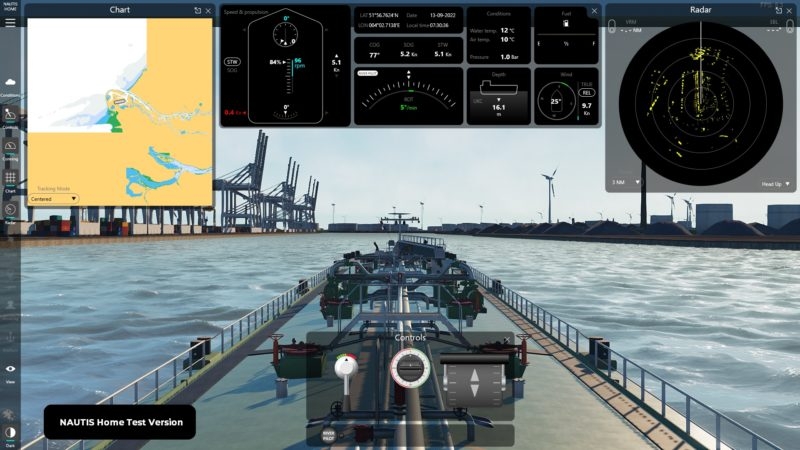VSTEP is about to release its new maritime simulator NAUTIS Home, offering access to simulation training from anywhere. In addition, to become acquainted with simulation-based learning, the Port of Antwerp-Bruges, MSG eG and Royal Boskalis have leased a Portable Simulator from the company.
On-premises maritime simulators are crucial in facilitating the right maritime education. ‘However, we noticed a strong demand from a much larger group interested in professional simulation software to which on-premises simulators are not accessible,’ says Fabian van den Berg, Chief Executive Officer of VSTEP. This group consists for example of maritime students, maritime hobbyists and even simulation enthusiasts, who currently do not have a suitable option to experience ship simulation.
Combined with other factors such as travel time to on-premises simulators, travel costs and Covid-19 restrictions, a demand arose in the market for a scalable and non-location bound simulation solution. ‘By bringing this new product to the market, we can increase the number of training hours significantly,’ says Van den Berg. He notes that this is one of the most disruptive products the maritime education market has seen in the last fifteen years.
‘We believe in an innovation where professional simulation software, learning and fun are combined in a scalable solution,’ comments Van den Berg. ‘NAUTIS Home evolved from our professional NAUTIS solutions for schools and businesses.’ This means NAUTIS Home will offer a similar level of immersion of 3D environments, realistic hydrodynamics, and quality graphics as the business solutions.
Also read: Vstep to integrate haptic feedback in its maritime simulators
Navigating realistic environments
NAUTIS Home will contain standardised content for individual sailing, training and assessment focused on basic navigation and manoeuvring. Users will be able to navigate realistic environments, such as Rotterdam, Hong Kong and New York, and sail with a variety of vessel types.
NAUTIS Home will release in Early Access in the last quarter of this year. The Early Access version of the software will be the basis on which they will continue to develop and improve. ‘An Early Access release gives us the opportunity to build a community from the start and collect feedback and input from the users. This way, we can adjust the development course and tailor the software towards the market needs for the long term,’ says Van den Berg.
Portable Simulator
The Portable Simulator is an accessible entrance point to maritime simulation training. While a full-mission bridge simulator might be an investment and require a lot of internal alignment, a Portable Simulator is a rather economical option. It gives organisations data points to decide whether it’s worth setting up maritime simulation training. This is what the Port of Antwerp-Bruges, MSG eG and Boskalis are aiming to achieve with their Portable Simulator. It gives them an indication about whether simulation could enhance their learning possibilities.
For the Port of Antwerp-Bruges, tug capitains, who are waiting onshore for the next assignment, can train manoeuvring and tugboat handling on the Portable Simulator. This reduces the lost time between operations and fosters learning. MSG eG, a shipyard in Germany, uses the simulator with conventional controls for two days at the Shipping, Technics and Logistics Event in Kalkar.
Dredging and offshore contractor Boskalis has opted for a simulator with conventional propellers. The company is planning to calculate the behaviour of a tug vessel, considering the power of the ship, wind, current and waves. Later, they are going to test their calculations on the Portable Simulator.
Picture: An image of NAUTIS Home in development, the interface is therefore susceptible to change. Panels are movable to secondary monitors.
Also read: VSTEP adds RH Marine’s ECDIS to maritime training simulators








